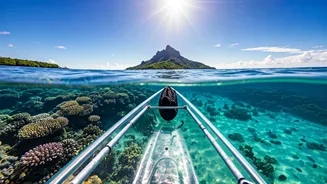Planning Your Expedition
Before plunging into the turquoise waters, meticulous planning is paramount for a successful multi-day kayak trip on Australia's 'other' reef. The initial
step involves determining the ideal time for the journey. The optimal period usually aligns with the dry season, running from May to October, as this brings more stable weather conditions, gentler breezes, and clearer visibility. Next, consider your kayaking experience level, as the reef can present challenging conditions depending on the specific location chosen. Experienced kayakers may embrace more remote and demanding routes, while novices might prefer guided tours or areas with calmer waters. Researching the reef's ecosystem is also crucial. Identify potential hazards, such as strong currents, exposed reefs, and weather patterns. Furthermore, you will need to map out your itinerary, selecting campsites or accommodations along the route. Reservations should be made in advance, especially during peak seasons. Remember to factor in distances between points, and potential navigation challenges. Don't forget to familiarize yourself with tide charts and weather forecasts. Finally, ensure all necessary permits are acquired. These permits are frequently required for camping or accessing specific areas. Careful planning sets the foundation for a safe and memorable kayaking adventure.
Essential Kayaking Gear
Packing the right kayaking gear is critical for comfort, safety, and a rewarding experience on Australia's 'other' reef. Begin with the kayak itself. Choose a sea kayak, preferably one designed for multi-day trips, with ample storage space for your equipment. Ensure it fits your size and paddling style comfortably. A well-fitted kayak minimizes fatigue. Next, focus on personal protective equipment. This includes a properly sized and snug-fitting life jacket. This is a non-negotiable safety item. A spray skirt keeps water out of the kayak, making paddling more comfortable, especially in choppy conditions. A reliable paddle is indispensable; it should be lightweight and matched to your height. Consider a spare paddle in case of breakage. Weather protection requires layering. Pack moisture-wicking base layers, insulating mid-layers, and a waterproof outer layer to accommodate variable conditions. Sun protection is equally vital. Bring a wide-brimmed hat, sunglasses with UV protection, and high-SPF sunscreen. Navigation tools are crucial, including a waterproof map, a compass, and a GPS device or a smartphone with a waterproof case and downloaded maps. A dry bag or waterproof containers are crucial to keep essential items safe from water damage. Finally, don't forget essential accessories such as a bilge pump or sponge for removing water from the kayak, a repair kit for your kayak, and a first-aid kit with any necessary personal medications.
Navigating the Reef Waters
Navigating the waters of Australia's 'other' reef requires a combination of skill, knowledge, and respect for the environment. Begin by studying the route. Utilize maps, charts, and guidebooks to become familiar with the area. Identify prominent landmarks, such as islands, headlands, and reef formations, to aid in your navigation. Check the weather forecast before departure and throughout the trip. Keep an eye on wind conditions, wave heights, and potential storms, and adjust your plans accordingly. Learn and follow the local navigational rules. These rules may include areas with restricted access. It is important to know the right-of-way regulations. Practice your paddling techniques to conserve energy and increase efficiency. Paddling with a consistent stroke and maintaining a good posture are essential for long distances. Be aware of currents, which can significantly affect your speed and direction. Pay attention to tide changes as they influence water levels, exposed reefs, and currents. When navigating near reefs, be cautious. Avoid damaging corals and other marine life. Maintain a safe distance, and paddle slowly in sensitive areas. Finally, stay hydrated. Drink plenty of water throughout the day. Avoid excessive exposure to the sun. Consider wearing long sleeves and pants for sun protection. Remember, safety always comes first.
Wildlife Encounters & Safety
Kayaking on Australia's 'other' reef presents amazing opportunities for wildlife encounters, but it's important to approach these experiences with caution and respect. The reef teems with marine life, including colorful fish, sea turtles, dolphins, and perhaps even whales, depending on the season. Maintain a safe distance from all animals, never approach or feed them. Observe them quietly, allowing them to behave naturally. If you encounter marine mammals, avoid sudden movements or loud noises that might startle them. Be aware of the potential hazards associated with wildlife, such as sharks or stingrays. While attacks are rare, it's wise to be prepared. Swim only in designated areas. Avoid wearing shiny jewelry, which can attract sharks. If you do encounter a shark, remain calm and slowly exit the water. Before you set out, make sure you know what to do in case of a medical emergency. Carry a comprehensive first-aid kit. Learn basic first-aid and CPR. Make sure you know how to signal for help. If an accident occurs, your safety is paramount. Alert the appropriate authorities, such as the marine rescue services or national park rangers. Ensure you and anyone with you knows how to handle various scenarios, and have necessary emergency contact information readily available.
Camping and Conservation
Camping responsibly and practicing conservation are crucial components of a sustainable kayaking adventure along Australia's 'other' reef. If you plan to camp, select designated campsites. Follow all the guidelines specified. Pack out everything you pack in. Leave no trace. Dispose of trash properly, including food wrappers, plastic bottles, and any other waste. Respect the natural environment. Avoid disturbing the vegetation, and do not make campfires unless permitted. When setting up your camp, choose areas that have already been impacted. Minimize your impact by setting up camp in an area away from sensitive vegetation or wildlife habitats. Conserve water. Use water sparingly. Take short showers, and avoid wasting water. Do not use harsh soaps or chemicals that can pollute the water. Learn about the local ecosystem and the importance of coral reefs. Educate yourself on the marine life, and the conservation efforts in place. Support sustainable tourism. Choose tour operators who are committed to environmental responsibility, and follow ethical practices. Be respectful of local cultures and communities. Learn about any cultural sensitivities, and follow the local customs. Preserve the beauty of the reef for future generations. Encourage others to practice responsible camping and conservation. Your actions matter. Enjoying the 'other' reef sustainably ensures that it continues to be a source of wonder and adventure for years to come.













